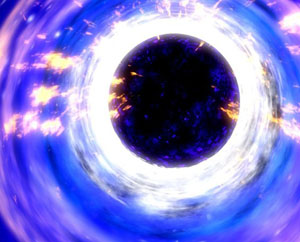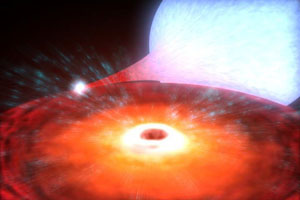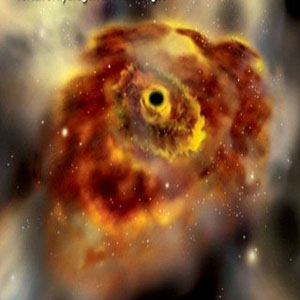You wait for one for ages and then three come along all at once. First, the smallest black hole ever seen with a mass just 3.8 times that of our Sun and a diameter of about 20 km has been observed in the Milky Way Galaxy binary system XTE J1650-500 in the southern constellation of Ara. Second, a well-known star cluster, Omega Centauri, which twinkles with the light of millions of stars seems to have at its core a dark object tugging on those stars. Finally, putatively the biggest black hole in the Universe was observed at the heart of the quasar OJ287 some 3.5 billion light years from Earth.
In 2007, Nikolai Shaposhnikov and Lev Titarchuk, of NASA’s Goddard Space Flight Center, used ESA’s XMM-Newton X-ray observatory to determine the mass of the black hole, Cygnus X-1, made famous by Canadian progressive rock band Rush in an eponymous song. Cygnus X-1 weighs in at just under 9 solar masses.

Lev Titarchuk
Now, the team has presented their discovery of the much smaller black hole to the American Astronomical Society’s High-Energy Astrophysics Division meeting in Los Angeles, California. This black hole is really pushing the limits, says Shaposhnikov, For many years astronomers have wanted to know the smallest possible size of a black hole, and this little guy is a big step toward answering that question.
The site of the black hole was first observed by NASA’s Rossi X-ray Timing Explorer satellite in 2001 and astronomers quickly realized that J1650 harbours a normal star and a suspected low mass black hole. Shaposhnikov and Titarchuk have now demonstrated with high precision just how low that mass is.

A top down view of the black hole (Credit: NASA/CXC/A. Hobar)
Their technique exploits the relationship between a black hole and the inner part of the surrounding accretion disk in which gas spirals inward before making the fatal plunge beyond the black hole’s event horizon. When the rate at which matter pours into the black hole reaches a fairly moderate rate, hot gas accumulates and releases torrents of energy at X-ray wavelengths. As the intensity of these X-rays varies with a quasi-periodic oscillation and the frequency depends on the mass of the black hole, the researchers were able to work out the size of the black hole XTE J1650-500.

An artist’s impression of XTE J1650-500, the smallest black hole ever observed orbiting a companion star. (Credit: NASA/CXC/A. Hobar)
In their 2007 work, Shaposhnikov and Titarchuk had applied their method to three black holes whose masses had been measured by other techniques. In their latest results, they extended the technique to seven more black holes, three of which had previously determined masses. In every case, our measurement agrees with the other methods, says Titarchuk, We know our technique works because it has passed every test with flying colours.

From one extreme to the other, the biggest black hole
When Shaposhnikov and Titarchuk applied their method to XTE J1650-500, they calculated a mass of 3.8 Suns, with a margin of uncertainty of only half a Sun. This value is well below the previous black hole record holder with a reliable mass measurement, GRO 1655-40, which tips the scales at about 6.3 Suns.
The researchers point out that there is a critical threshold of mass below which a dying star will form a neutron star instead of a black hole. Astronomers suspect this threshold lies between 1.7 and 2.7 solar masses. Determining an increasingly precise value for a smaller black hole, will provide new insights into the behaviour of matter under extreme conditions.
The discovery of a medium-sized black hole in Omega Centauri, the largest and brightest globular cluster in the sky, was made with Hubble Space Telescope images and data from the GMOS spectrograph on the Gemini South telescope in Chile. The data could explain some of the bizarre characteristics of the Omega Centauri cluster. This result shows that there is a continuous range of masses for black holes, from supermassive, to intermediate-mass, to small stellar mass types, explains team leader Eva Noyola of the Max-Planck Institute for Extraterrestrial Physics in Garching, Germany.
Finally, the biggest black hole yet observed weighs in at an incredible 18 billion times the mass of the Sun and is itself orbited by a smaller black hole of just 100 million solar masses. Unlike the smallest black hole there is theoretically no upper limit on the size of a black hole. Craig Wheeler of the University of Texas in Austin, who observed OJ287, says it depends only on how long a black hole has been around and how fast it has swallowed matter in order to grow. There is no theoretical upper limit, he says.
Further reading
HEAD 2008, High Energy Astrophysics Division 10th Meeting
http://www.confcon.com/head2008/
News release from the European homepage for the NASA/ESA Hubble Space Telescope
http://www.spacetelescope.org/news/html/heic0809.html
Suggested searches
black holes